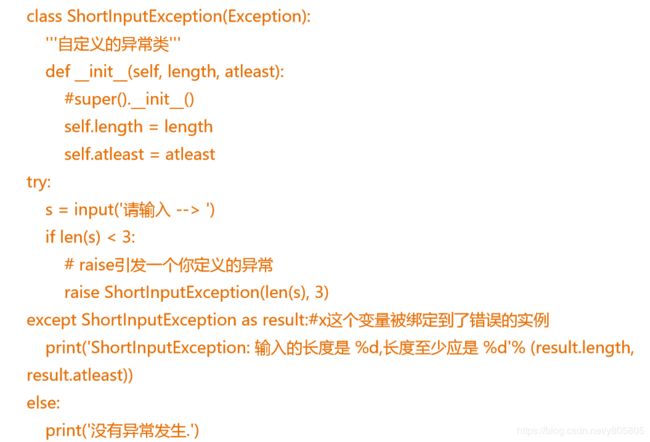python——面向对象(下)
异常简介
异常,即程序中出现的错误
open("a.txt")
此时文件不存在,在执行程序是将显示如下:
Traceback (most recent call last): File "test.py", line 1,
in
捕获异常
异常一旦发生,如果不加以处理,则程序中断。 如何能够提高程序的健壮性?对于一般可预测性的异常,我们一般可以事先预防 即就是当程序出现问题时,我们有预先的处理机制。
try except语句
try:
print("异常发生前")
open("a.txt")
print("异常发生后")
except IOError:
print("捕捉到了异常")
把可能出现问题的代码,放在try中
把处理异常的代码,放在except中
except也可以一次性捕捉多个异常:
try:
print("异常发生前")
print(num)
open("a.txt")
print("异常发生后")
except (IOError,NameError):
print("捕捉到了异常")
也可用as关键字将异常信息存储:
try:
print("异常发生前")
print(num)
open("a.txt")
print("异常发生后")
except (IOError,NameError) as result:
print("捕捉到了异常") print(result)
嫌麻烦也可一次性捕捉所有异常:
try:
print("异常发生前")
print(num)
open("a.txt")
print("异常发生后")
except Exception as result:
print("捕捉到了异常")
print(result)
else如果没发生异常则执行:
try:
print("异常发生前")
#print(num)
#open("a.txt")
print("异常发生后")
except Exception as result:
print("捕捉到了异常")
print(result) else: print("万幸")
finally无论错误与否,都要执行:
try:
print("异常发生前")
#print(num)
#open("a.txt")
print("异常发生后")
except Exception as result:
print("捕捉到了异常")
print(result) finally:
print("必须执行!")
栗子一:
try:
print num
print("Before error")
open("a.txt")
print("After error")
except IOError,NameError) as e:
print(e)
print("Except run...")
else:
print("Else run...")
finally:
#无论错与否 都要执行
#主要去关闭一些资源 close
print("Finally run...")
异常的传递
如果一个异常是在一个函数中产生的,例如函数A---->函数B---->函数C,
而异常是 在函数C中产生的,那么如果函数C中没有对这个异常进行处理,那么
这个异常会传递到 函数B中,如果函数B有异常处理那么就会按照函数B的处理
方式进行执行;如果函数B也 没有异常处理,那么这个异常会继续传递,
以此类推。。。如果所有的函数都没有处 理,那么此时就会进行异常的默认处理,
即通常见到的那样
当调用test3函数时,在test1函数内部产生了异常,此异常被传递到test3
函数中完成了异常处理,而当异常处理完后,并没有返回到函数test1中进行执行,
而是在函数 test3中继续执行栗子二:
def test1():
print("1-1")
print(num)
print("1-2")
def test2():
print("2-1")
test1()
print("2-2")
test2()
def test3()
try:
print("3-1")
test1()
print("3-2")
except Exception as e:
print(e)
print("3-3")
#角标越界异常
class IndexOutOfBoundExcption(Exception):
def __init__(self,index,info):
self.index=index
self.info=info
def __str__(self):
return "IndexOutOfBoundExcption!Because of :%s"%(self.index)
def show(l,index):
if index<0 or index>=len(l):
raise l[index]
print l[index]
l=[1,2,3]
try:
show(1,-5)
except IndexOutOfBoundExcption as e:
print(e)
#test2()
test3()抛出自定义异常
可以用raise语句来引发一个异常。异常/错误对象必须有一个名字,且它们应是Error或 Exception类的子类
异常处理中抛出异常
栗子三:
'''
老师上课
老师
电脑
开机
蓝屏
冒烟
重启
'''
class Teacher:
def __init__(self):
self.name=name
self.computer=computer
def teach(self):
try:
self.computer.start()
except BlueScreenException as e:
self.computer.restart()
except MaoYanException as e:
print(e)
print(self.name+"class begining!")
class Computer:
def __init__(self,type):
self.type=type
def start(self):
print("computer running...")
if type==1: #BlueScreen
raise.type==1:
if type==2: #Maoyan
raise MaoYanException()
def restart(self):
print("The computer is restart")
print("The computer is running")
class BlueScreenException(Exception):
def __str__(self):
return "The computer is BlueScreen now!"
class MaoYan(Exception):
def __str__(self):
return "The computer is MaoYan now!"
class ClassNotContinueException(Exception):
def __str__(self):
return "go home now!"
com=Computer(0)
teacher=Teacher("teacher",com)
try:
teacher.teach()
except ClassNotContinueException as e:
print(e)
printt("Go home")
teacher.teach()模块介绍
C语言中如果要引用sqrt函数,必须用语句#include
import:
在Python中用关键字import来引入某个模块,比如要引用模块math,就可以在文件最开始的地方用import math来引入。
在调用math模块中的函数时,必须这样引用:
模块名.函数名
模块制作
定义自己的模块:
在Python中,每个Python文件都可以作为一个模块,模块的名字就是文件的名字。 比如有这样一个文件test.py,
在test.py中定义了函数add
test.py
def add(a,b):
return a+b
调用自己的模块:
那么在其他文件中就可以先import test,然后通过test.add(a,b)来调用了,当然也可以通 过from test import add来引入
main.py
import test
result = test.add(11,22)
print(result)
给程序传参数
import sys
print(sys.argv)



